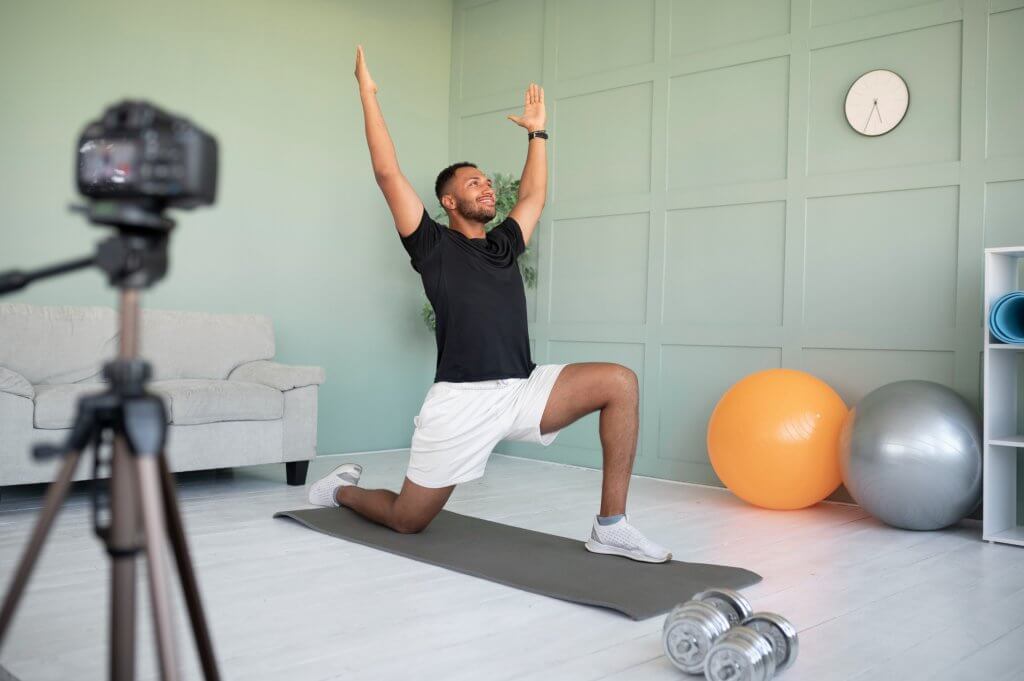How to Become a Personal Trainer: Your Complete Guide
Trainer GuideBecoming a personal trainer isn’t just a job—it’s an opportunity to make a real difference in people’s lives by helping them achieve their health and fitness goals. As a personal trainer, you have the power to design customized workout programs, build strong relationships with clients, and create a lasting impact on their well-being.
If you’re considering this career path, personal training offers endless opportunities for growth. You can specialize in areas like nutrition or corrective exercises, or even build your own business through freelance training or online coaching.
With Super Coach’s guidance and support, you’ll gain clear, practical steps to turn your passion for fitness into a stable and successful career. This guide provides a comprehensive roadmap to help you get started and answer the key question: How do you become a personal trainer?
Are you ready to start your journey?

Understand What Personal Trainers Do
A personal trainer helps clients achieve their fitness goals by understanding their current physical abilities and creating customized workout programs. They ensure exercises are done safely, motivate clients during sessions, and provide regular feedback to track progress. Additionally, they educate clients on lifestyle changes, including nutrition and wellness habits, to support overall health.
For further clarification, here are the key executive tasks of a personal trainer:
1. Empower Clients: Help individuals embrace healthier, stronger versions of themselves by providing guidance and motivation.
2. Design Tailored Programs: Create customized workout plans based on each client’s specific goals (e.g., strength, endurance, recovery).
3. Motivate and Support Clients: Address both physical and mental aspects of training to foster a well-rounded approach to health.
4. Build Strong Client Connections: Develop personal relationships with clients to understand their unique needs and goals.
5. Stay Updated on Industry Trends: Continuously enhance your knowledge by attending workshops, earning certifications, and reading the latest studies.
6. Commit to Lifelong Learning: Regularly invest in professional development to ensure you’re offering the most effective techniques and advice.
7. Embrace the Impact of Your Role: Recognize your ability to positively influence lives and treat each session as an opportunity to inspire change.

Steps to Becoming a Personal Trainer
Step 1: Evaluate Your Passion and Skills
Becoming a personal trainer isn’t just about loving fitness; it’s about channeling that passion into helping others achieve their goals. Before jumping into this career, take a moment to reflect on what drives you and whether you have the mindset and skills to thrive in this industry. This self-assessment is the foundation of building a successful, fulfilling career.
Start by asking yourself a few key questions:
- Why do I want to become a personal trainer? Is it purely for your love of fitness, or do you also enjoy teaching and inspiring others?
- Am I ready to commit to continuous learning? The fitness industry evolves quickly, and staying relevant requires dedication to ongoing education.
- Can I adapt to working with different personalities and fitness levels? From beginners who need encouragement to experienced athletes seeking optimization, every client brings unique challenges.
Answering these questions honestly will help you determine if this is the right path and prepare you for the journey ahead.
Step 2: Choose the Right Certification
How to become a certified personal trainer? Choosing the right certification is one of the most critical decisions in your journey to becoming a personal trainer. It’s not just about ticking a box, it’s about establishing your credibility, building your knowledge base, and positioning yourself as a trusted professional in the fitness industry.
finding the certification that aligns with your goals, budget, and career aspirations requires careful consideration.
With so many options available, start by exploring the most appreciated and powerful certifications in your country, and consider the other requires of goals, budget, and career progress.
Each certificate comes with its unique strengths, so understanding what they offer is key:
- ISSA: Known for its flexibility and online-first approach, ISSA is ideal for those who need a self-paced learning model. It covers a broad range of topics and offers specializations in areas like strength training and nutrition.
- ACE: ACE focuses on a well-rounded approach to personal training, emphasizing behavior change and client-centered coaching. It’s a great option if you’re passionate about helping clients make sustainable lifestyle changes.
- NASM: Widely recognized for its emphasis on biomechanics and corrective exercise, NASM is perfect for trainers looking to work with clients who have specific physical needs or limitations.
- ACSM: Known for its rigorous, science-driven curriculum, ACSM is a top choice for trainers interested in working with clinical populations or advancing into research and academia.
When selecting a personal training certification, evaluate these key factors to make an informed decision:
- Cost: Certification prices range from hundreds to thousands of dollars. Factor in additional costs like study materials, exam fees, and renewals to understand the full investment.
- Reputation: Choose certifications accredited by recognized organizations such as NCCA or DEAC, as these are trusted by employers and clients globally.
- Specialization Options: Align your certification with your career goals by selecting programs that offer specializations relevant to your interests, such as sports performance, senior fitness, or medical conditions.

Step 3: Pass Certification Exams
Passing your certification exam is a crucial milestone on your path to becoming a personal trainer.
While the idea of taking an exam might feel overwhelming, a structured approach to studying and understanding the exam format can set you up for success.
Here are some study tips and strategies for Exam Success:
1. Create a Study Plan: Start by reviewing the exam syllabus and breaking it into manageable sections. Allocate specific topics to each study session and set realistic deadlines to cover the material thoroughly.
2. Use Official Study Materials: Most certification programs provide comprehensive resources, including textbooks, practice exams, and online portals. Stick to these trusted materials, as they are designed to align closely with the exam content.
3. Practice, Practice, Practice: Take full advantage of practice exams to familiarize yourself with the question format and identify areas where you need improvement.
4. Join Study Groups: Connect with others who are preparing for the same certification. Sharing insights and discussing challenging topics can make the process more engaging and effective.
5. Focus on Weak Areas: Pay special attention to topics you find challenging, whether it’s biomechanics, nutrition, or program design. Revisit these sections and seek additional resources, such as tutorials or videos, to reinforce your understanding.
Step 4: Gain Knowledge and Hands-On Experience
This step is where theory meets practice, transforming your knowledge into the expertise clients trust and rely on. Becoming a personal trainer goes beyond earning a certification it’s about building a solid foundation in fitness principles and gaining important practical skills.
- A comprehensive understanding of anatomy, nutrition, and exercise science is the backbone of effective training.
- Study key topics such as muscle groups, joint mechanics, and how different exercises target specific areas.
- Understanding nutrition is equally critical, as many clients will seek advice on fueling their workouts and achieving their goals through balanced diets.
- Finally, becoming familiar with exercise science principles ensures that your programs are safe, effective, and adaptive to changing client needs.
However, knowledge alone isn’t enough. Hands-on experience is what turns an aspiring trainer into a skilled professional. Here are some tricks to start your real experience to become a personal trainer:
Start by shadowing experienced trainers. Observing their interactions with clients, how they adapt to different fitness levels, and their approach to problem-solving offers invaluable insights. Ask questions, take notes, and analyze how they build trust and engagement with their clients.
- Volunteering at local gyms, community centers, or fitness events is another great way to gain exposure. This allows you to work with diverse populations, from beginners to seasoned athletes.
- If you have the opportunity, secure an internship with a fitness organization. Internships provide structured learning environments where you can apply your skills under the guidance of seasoned professionals.
- Creating an interlinked network. Working in either of the earlier choices could be an excellent method to network and possibly land a job when you’re ready to begin your career.
By investing time in both education and practical experience, you’ll develop the skills and confidence needed to stand out as a personal trainer.

Step 5: Start Building Your Career
Once you’ve earned your certification, it’s time to step into the fitness world and start building your career as a personal trainer. This phase is where you take the knowledge and skills you’ve gained and put them into action.
Success at this stage depends on making smart decisions about your work setting, building a client base, and showcasing your expertise to attract opportunities.
Choosing Your Work Setting!
The first decision to make is where you want to work. Each option comes with its own benefits and challenges:
1. Gym-Based Training: Starting at a gym is one of the most popular paths for new trainers. Gyms provide access to a steady stream of potential clients, built-in resources like equipment and facilities, and opportunities to learn from experienced colleagues.
However, gyms often take a percentage of your earnings, so consider the financial implications.
2. Freelance Training: If you prefer more flexibility and control over your schedule, freelance training might be the right fit. You can train clients in their homes, outdoors, or at private studios. While freelancing offers greater independence, it requires strong marketing and organizational skills to find clients and manage your business.
3. Online Coaching: The rise of digital fitness has opened the door to online coaching, where you can work with clients remotely. This model allows you to reach a global audience and create scalable income streams through virtual programs or group coaching. However, building trust and engagement in a digital environment takes time and effort.
Building an Initial Client Base
1. Leverage Your Network: Start by reaching out to friends, family, and acquaintances who might be interested in personal training. Offer discounted or free sessions in exchange for testimonials or referrals to kickstart your client base.
2. Build Your Online Presence: Establish yourself on social media platforms like Instagram, Facebook, or LinkedIn to connect with potential clients and share valuable fitness content. Consistently post tips, workout videos, and client success stories to showcase your skills and engage your audience.
3. Partner with Local Businesses: Collaborate with nearby gyms, wellness centers, or community groups to gain exposure. Offering workshops or fitness classes can help you reach new clients and build your reputation in the local community.
The Online Coaching Platform is a viable choice! (For instance, SuperCoach ) You can also create your own account on the online coaching platform to demonstrate your skills and services.
4. Offer Introductory Packages: Lower the barrier to entry for new clients by offering special promotions, such as discounted first sessions or trial packages. These incentives encourage people to give your services a try, and once they see results, they’re more likely to continue.
Showcase Your Expertise
Develop a Professional Portfolio: Showcase your expertise with a portfolio that highlights your credentials, training philosophy, and success stories. Include before-and-after photos (with client consent), testimonials, and examples of customized workout plans. A strong portfolio builds credibility and helps potential clients understand the value you offer.
Focus on Building Relationships: A strong client-trainer relationship is the key to retention and referrals. Take time to understand each client’s goals and challenges, and celebrate their progress to keep them motivated and engaged. Happy clients are your best advocates.
Unlock Your Potential with SuperCoach
Are you ready to take charge of your personal training career and thrive in freelancing or online coaching? SuperCoach is your ultimate partner for success!
- Gain access to proven strategies for building a standout personal brand.
- Master client engagement with expert tools and resources.
- Learn how to scale your fitness business and achieve sustainable growth.
Whether you want to dominate the freelance market or expand into online coaching, SuperCoach has the expertise to guide you every step of the way.
👉 Join SuperCoach today and take the next step toward building the career you deserve!

Step 6: Practical Application & Marketing Your Business
Once you’ve laid the groundwork by choosing your work setting and building an initial client base, the next step is to apply your skills practically while effectively marketing your services to grow your business.
Putting Your Skills Into Action
Practical application involves more than running workout sessions; it’s about creating an exceptional client experience that drives results and loyalty. Focus on these key aspects:
- Personalized Programs: Tailor your training plans to meet each client’s specific goals, fitness level, and preferences. Regularly reassess and adjust the programs to keep them aligned with progress and changing needs.
- Tracking Results: Use tools like fitness apps, progress photos, or detailed records to measure and demonstrate results. Clients value tangible evidence of their achievements, and tracking their progress keeps them motivated.
- Continuous Engagement: Keep sessions engaging and dynamic. Introduce new exercises, training methods, or challenges to prevent monotony and maintain enthusiasm.
- Feedback and Communication: Actively seek feedback from your clients to improve your services. Open communication fosters trust and helps you address any concerns proactively.
Marketing Your Personal Training Business
Growing your business requires a solid marketing strategy to attract new clients and retain existing ones. Here’s how to effectively market your services:
1. Create a Strong Online Presence:
- Develop a professional website or landing page showcasing your credentials, client success stories, and services.
Instead, you can cut corners and only register on SuperCoach to have a well-established website connected with all the tools and tracking systems you will need to manage your clients.
- Utilize social media platforms to share workout tips, client testimonials, and success stories.
- Invest in SEO (search engine optimization) to make it easier for potential clients to find you online when searching for personal training services.
2. Leverage Testimonials and Referrals:
- Happy clients are your best marketing tool. Encourage satisfied clients to share their experiences through online reviews, testimonials, or word of mouth.
- Set up a referral program offering discounts or perks to clients who bring in new customers.
3. Offer Value-Driven Content:
Share valuable fitness advice through blogs, videos, or newsletters. Position yourself as a knowledgeable authority by educating your audience on topics like nutrition, recovery, and effective training techniques.
5. Build Your Brand:
Develop a unique personal brand that resonates with your target audience. Whether it’s a focus on holistic wellness, athletic performance, or weight loss, make sure your messaging is consistent and reflects your expertise.

Frequently Asked Questions
Q1: How Long Does It Take to Become a Certified Personal Trainer?
Typically, it is 3-6 months, depending on your chosen program and pace.
Q2: Do I Need a Degree to Become a Personal Trainer?
No, but certifications and expertise in exercise science are essential.
Q3: What Are the Best Certifications for Personal Trainers?
NASM, ACE, ISSA, and ACSM are highly regarded globally.
Q4: How Much Can I Earn as a Personal Trainer?
Salaries vary by location, experience, and specialization, with the potential for six figures with the right approach.
Q5: Can I Be a Personal Trainer Without Certification?
While possible in some regions, certification builds credibility and trust with clients.
